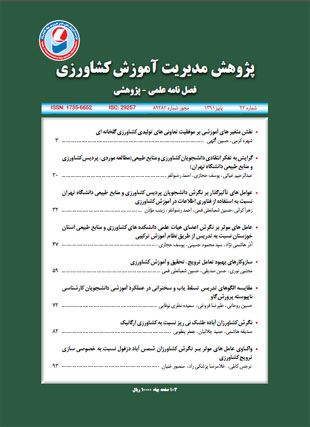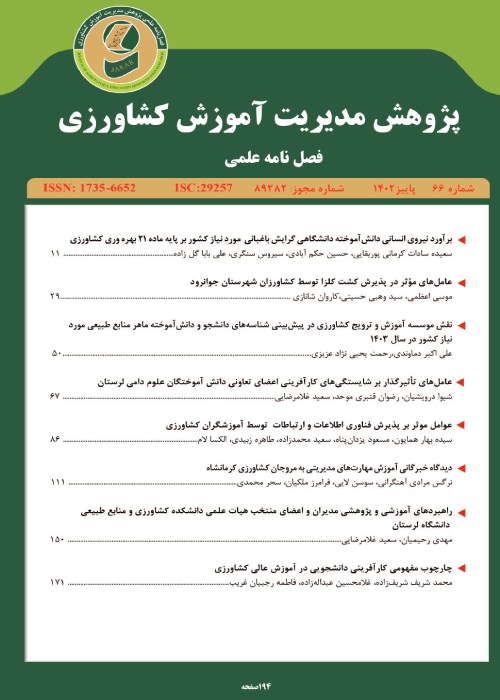فهرست مطالب

نشریه پژوهش مدیریت آموزش کشاورزی
سال چهارم شماره 22 (پاییز 1391)
- تاریخ انتشار: 1392/02/25
- تعداد عناوین: 8
-
-
Page 3Education in a cooperative, as a basic infrastructure has an important role and effect on the activities of cooperatives, from various aspects. Thus, the purpose of this research was to study the role of educational factors effecting success of greenhouse agricultural cooperatives (GAC). Statistical population of the study consisted GAC producers in Kermanshah Province. Stratified random sampling was used to select 220 members of these cooperatives. Information gathered through questionnaire, and validity of the instrument was done by a panel of expert at the department of Agricultural Education and Extension and cooperative officers. The reliability of questionnaire was done by Chornbach's alpha coeffient (α=0/90). Data analysis was done SPSS. Results of path-analysis showed, complicated communication between these variables which was in turn showing no significant correlation between them, and educational factors. In addition, direct effect, has also indirect effects via personality factors, social-cultural, management, economic in success of GAC producers. Total effect indicating specific role of educational factors in success of greenhouse agricultural cooperatives.Keywords: Educational Factors, success, Greenhouse Agricultural Cooperatives, path analysis
-
Page 20The main purpose of this study was to investigate critical thinking disposition of agricultural students, of Agricultural and Natural Resources, University of Tehran. The statistical population of the study consisted of 3859 agricultural and natural resources students in 2009-2010 academic year of Agriculture and Natural Resources, University of Tehran from that 185 students were randomly selected. Data were gathered through the application of an instrument consisted of two parts including Facione's “California Critical Thinking Disposition Scale (1992), and demographic data. The research instrument was given to the academic staff of the department of agricultural extension and education, University of Tehran totest its content validity. Cronbach alpha was calculated to measure reliability of items of critical thinking disposition a = 0.69 - 0.87. Data were analyzed using SPSS version 15. Results showed that agricultural students had a positive disposition towards critical thinking although respondents in some subscales (analyticity, truth-seeking and critical thinking self-confidence) were ambivalently disposed towards critical thinking. Also, results indicated that there was no significant difference in critical thinking disposition between undergraduate and graduate students.Keywords: Critical thinking, critical thinking disposition, agricultural students, agricultural education
-
Page 32
This investigation carried out to investigat the attitude of agricultural and natural resources students towards application of IT at University College of Agriculture and Natural Resources, University of Tehran.The research was conducted as a descriptive–correlation. The staticsitcal population was all students of the University College (N=3143) fram that 218 students were selected as statistical sample by using a stratified sampling method and Cochran statistics.The data were gathered by a questionnaire which made by researcher and it is content validity was confirmed by using a panel of experts consisting of IT and senior faculty members in agricultural extension and education. Cronbach’s alpha showed that the reliability of questionnaire was desirable. The results indicated that 88/5 percent of students had positive attitude toward applicat of information technology in Agricultural higher education. Results of regression analysis indicated that English skills, internet use skills, computer skills, using internet and computer expiained 47/1 percent of the variance in the dependent variable(IT). The results of path analysis showed that, English language skills, use of internet, Computer application skills, internet use skills, and the use of computer directly effected the attitude of towards the use of IT.
Keywords: Agricultural student, attitude, information technology, agricultural higher education -
Page 47The purpose of this research was to investigat Attituds of Khuzestan Agricultural and Natural Resources faculty members toward teaching through Blended Learning. Statistical population of the study consisted of 159 agriculture and natural resources faculty members out of which 72 members were selected as sample using simple random sampling. Questionnaire was used as the main instrument to collect data. Validity of the questionnaire was approved by a panel of experts in the field of Agricultural Extension and Education at the University College of Agriculture and Natural Resources, University of Tehran. Reliability of the questionnaire also was approved by calculating Cronbach’s Alpha coefficient as α= 0.86. The results of correlation calculation showed that there is positive significant relation between respondents’attitude and the average hours of using computer and using internet at P= %1, as well as with teaching experience, research activities, participation in educational workshop at P= %5. Results of linear multiple regression analysis revealed that variables of using internet, teaching experience, using computer and participation in educational workshop expressed 61.5 percent of respondents’ attitude variance.Keywords: Faculty member's attitude, blended learning, educational workshop
-
Page 59This study is to investigate the strategies of improving interaction of education, extension, and research from the agricultural extension expert's perspective. This is a survey research which is descriptive – exploratory in nature. The statistical population of this study is consisted agricultural extension education experts (N=140) including: faculty members of agricultural extension and education (N1=60), senior managers of agriculture extension and education organization (N2=35), and post graduate students of the agricultural extension and education (N3=45).The literature has been reviewed to determine the strategies of improving interaction of education, extension, research to organized the research questionnaire. The questionnaire distributed among the population of the study. After conducting the follow up procedures, 96 questionnaires collected and data analyzed, using SPSS. Content and face validity of the questionnaire was investigated and approved by a panel of experts in agricultural extension and education. Reliability of the questionnaire was assessed by conducting a pilot test. Results showed that, from the agricultural extension education expert's point of view, the best strategy of improving interaction of education and extension is using new communication technologies. In addition, the best strategy of improving the interaction of extension and research is planning, designing, and conducting participatory activities. Further results showed that there is a deep gap between the importance and degree of application of strategies. Results are useful to giving priority to the determined strategies and improving the interaction of education, extension, and research utilizing those strategies in Iran.Keywords: Improving the interaction, interaction of education, extension, research, extension experts, participatory activities
-
Page 72
In order to compare the effects of mastery and lecture-teaching patterns on educational performance of undergraduate students of animal food processing course the experiment was carried out by using pre-test / posttest control group design. The statistical population was 47 graduate students of animal food processing graduate in the first semester of 2009-2010 academic year, and being homogenized based on the average technician courses, acceptance quota, age, field technician, pre-test scores and previous semester divided into two experimental and control groups each with 21 students. In this survey research instrument consisted of demographic information, test questions, lesson plans (fitted for pattern of teaching mastery), and opinion of student (in each experimental group). Results showed that there was positive significant correlations between, technician courses average and previous semester grad average and then with post-test scores in experimental group. There was also positive significant correlations between previous semester average score with post-test score and pre-test scores with post-test scores. The results obtain from the comparing average score in pre-test and post-test groups also showed that there was no existed significant difference between experimental and control group but there was a significant difference within the post-test group. finaly the experimental group showed that teacher's ability in teaching mastery" was in the top priority.
Keywords: Teaching patterns, mastery teaching, lecture teaching, educational performance -
Page 82Organic agriculture is an approach towards healthy nutrition and environmental sustainability, although, has a long background, but is recognized in 1970s by scientific associations in the world. While it has been considered in our country, recently. This research aimed to study the attituds of farmers towards organic farming. As a descriptive survey research method a semi structured questionnaire was provided and applied. The number of samples was n=264 out of N=1468 landowners in six villages which were determined by Cochran Table. Validity of the questionnaire is accessed by a number of subject specialists and academicians, and its reliability was measured by using Cranach's alpha (α= 0.88). Results showed that 20.5 percent of farmers̕ attituds to organic farming were positive and 33.2 Percent had a relatively positive attitude and believed it to be better than industrial agriculture.Keywords: Sustainable Agriculture, Organic Products, Farmers Attitude, Abade Tashk
-
Page 93This study was conducted to analize factors affecting Shamsabad farmers, attitudes towards privatization of agricultural extension activities and its obstacles in, Khuzestan. to achieve a fairavall privatization system. The target population of this field study include all farmers in Shmsabad (N=175). Applying Krejcie and Morgan sampling table, and ratio stratified randomized sampling method, 120 farmers were choosen as the research sample. Data were collected through questionnaire and analyzed by SPSS version 16. Cronbach’s Alpha coefficients far questionnaire were 0.82-0.89. Results revealed that 21.1 percent of the respondents expressed negative attitudes towards privatization of agricultura and 8 percent had a positive attitude. Findings of the study showed That technical and advisory services,with the average of 6.77 out of 10 processed agricultural products, with the average 6.45 as the first and second preferences transferred to the private sector from the perspective of farmers, Training classes, with the average 5.19, and packaging products with the lowest average (5.07) allocated to farmers from the perspective of the last Rank.Keywords: Privatization, agriculture, agricultural extension, farmers, Shmsabad


